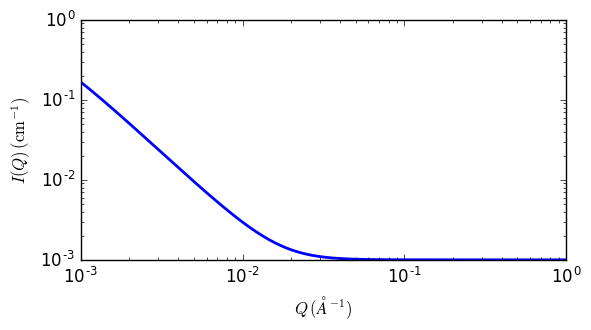mass_surface_fractal
Mass Surface Fractal model
| Parameter | Description | Units | Default value |
|---|---|---|---|
| scale | Source intensity | None | 1 |
| background | Source background | cm-1 | 0.001 |
| fractal_dim_mass | Mass fractal dimension | None | 1.8 |
| fractal_dim_surf | Surface fractal dimension | None | 2.3 |
| rg_cluster | Cluster radius of gyration | Å | 86.7 |
| rg_primary | Primary particle radius of gyration | Å | 4000 |
The returned value is scaled to units of cm-1 sr-1, absolute scale.
A number of natural and commercial processes form high-surface area materials as a result of the vapour-phase aggregation of primary particles. Examples of such materials include soots, aerosols, and fume or pyrogenic silicas. These are all characterised by cluster mass distributions (sometimes also cluster size distributions) and internal surfaces that are fractal in nature. The scattering from such materials displays two distinct breaks in log-log representation, corresponding to the radius-of-gyration of the primary particles, \(rg\), and the radius-of-gyration of the clusters (aggregates), \(Rg\). Between these boundaries the scattering follows a power law related to the mass fractal dimension, \(Dm\), whilst above the high-Q boundary the scattering follows a power law related to the surface fractal dimension of the primary particles, \(Ds\).
Definition
The scattered intensity I(q) is calculated using a modified Ornstein-Zernicke equation
where \(R_g\) is the size of the cluster, \(r_g\) is the size of the primary particle, \(D_s\) is the surface fractal dimension, \(D_m\) is the mass fractal dimension, \(\rho_{solvent}\) is the scattering length density of the solvent, and \(\rho_{particle}\) is the scattering length density of particles.
Note
The surface ( \(D_s\) ) and mass ( \(D_m\) ) fractal dimensions are only valid if \(0 < surface\_dim < 6\) , \(0 < mass\_dim < 6\) , and \((surface\_dim + mass\_dim ) < 6\) .

Fig. 95 1D plot corresponding to the default parameters of the model.
References
P Schmidt, J Appl. Cryst., 24 (1991) 414-435 Equation(19)
A J Hurd, D W Schaefer, J E Martin, Phys. Rev. A, 35 (1987) 2361-2364 Equation(2)